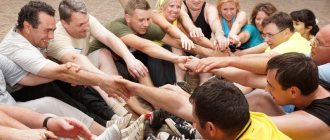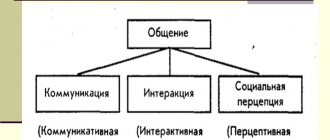The mechanism of human communication includes far more than just speech and writing. Since ancient times, people have resorted to alternative ways to express their thoughts or show their attitude towards something. Such non-verbal means of contact as gestures, facial expressions and pantomime can also serve as indicators of the interlocutor’s reaction or speak about his emotional state.
According to psychologists and science specialists who study human communication, more than half of the content of information exchange is transmitted non-verbally.
The concept of nonverbal communication in psychology
Gestures, facial expressions, pantomimes (as means of communication) are methods of non-verbal contact or a way of speaking without the help of words. In many materials on this topic, the definitions of nonverbal behavior, communication and communication are used as synonyms, but experts share these concepts that are close in meaning.
Nonverbal communication expresses the emotional states of those in contact and the nature of their communication. It includes non-verbal codes, signs and symbols independent of the social and psychological properties of the individual, which significantly increase the accuracy of the transmitted information.
Nonverbal behavior consists of body movements, gestures, glances, facial expressions and pantomimes that can show a person's attitude, reaction or signal something.
Non-verbal communication combines behavior and communication as the main ways of influencing an interlocutor, establishing interaction with him, creating an image and idea of a partner.
These means of information exchange, which include gestures, facial expressions and pantomime, are also called:
- natural;
- primary;
- secondary;
- artificial languages.
Communication nonverbal communication
Psychologists mainly study nonverbal means of information exchange, but there are also narrower specializations. For example, a discipline dedicated to body language is kinesics, although its research is divided into separate areas that study signal movements, gestures of the limbs and head, postures and facial expressions.
Nonverbal communications are widely used in the media, sports, politics, marketing, business, theater, advertising, pedagogy, and they are also in demand in the work of government law enforcement agencies.
The mechanism that combines types of non-speech information exchange to give them some meaning is called coding.
It has the following characteristics:
- Certain codes of nonverbal communications are universal, as they are determined by human biological development. These include physiologically based emotional reactions and threat signals.
- Meanings in coding can be expressed through voice, body, face and other means of non-verbal communication.
- Messages in nonverbal encoding should provoke an automatic reaction without thinking (for example, reacting to a traffic light changing colors).
- Nonverbal signs may occur involuntarily, examples include spontaneous blushing, muscle tension, and similar reactions.
- Means of non-verbal communication are equal to verbal dialogue. Communication through them occurs through body movements and other means of human expression, as well as elements of the environment.
Types of nonverbal communication
Gestures, facial expressions, pantomimics as a means of communication, in addition to enriching it, can serve to express emotions, agreement or disagreement, endow the situation with additional meaning, bring those in contact to a different level of mutual understanding and guide the interpretation of speech.
They are often used in education and to communicate with those suffering from hearing loss. Thanks to methods of non-speech information exchange, it is possible to both strengthen and weaken the influence of speech influence.
Some experts equate types of nonverbal communication with ordinary languages due to their information richness. They are classified depending on the types of human perception and how the information received is processed.
In total, there are 9 types of information exchange without the help of words, but this number may change due to the fact that its related types are sometimes combined into one direction.
| Language of nonverbal communication | Scope of use |
| Vocals | Features of the sound of speech and its intonation |
| Haptics | Also called takeshika and refers to meaningful touch. |
| Artifacts | Appearance attributes such as cosmetics, jewelry and clothing |
| Olfactics | Smells |
| Physics | Physical characteristics such as hair color, body shape and size |
| Aesthetics | Color, music |
| Chronicle | Time-based perception |
| Kinesics | Body movements and gestures |
| Proxemics | Perception of public and personal space |
Gestures
The list of communications without the use of speech includes a large number of gestures, with the help of which one can characterize a person’s real thoughts and intentions. The following are the most common combinations of gestures that are signs of certain conditions.
Mistrust:
- palm covers mouth.
Critical attitude:
- one hand supports the elbow of the other hand;
- the hand is located under the chin, and its index finger is extended along the cheek.
Superiority:
- the eyelids are slightly closed;
- hands thrown behind the head;
- sitting position with one leg crossed over the other.
Uncertainty:
- the fingers of one hand clasp the elbow of the other hand;
- touching the ears with your hands, rubbing them, scratching them or touching the earrings.
Boredom:
- stooping or hunching;
- the body is in a relaxed state;
- hand supports head.
Concentration:
- rubbing or pinching the bridge of the nose, handling glasses;
- touching and rubbing your chin with your hands;
- eyes are closed or squinted.
Disapproval:
- tugging and straightening clothes, depicting shaking them off from the dust of movement;
- shrugging shoulders.
Goodwill:
- the body is in a relaxed state;
- the shoulders are in an open position;
- arms spread to the sides;
- the head is directed forward and the palms are up.
Positive attitude:
- hand touching cheek;
- The body and head are tilted forward.
Pose
Body position is one of the determining criteria in assessing the attitude of the interlocutor and his intentions. You can characterize a person’s thoughts and perception of what is happening using the following poses.
Lack of frankness and completeness in dialogue with the interlocutor:
- standing with partial support on a chair, table or other strong support.
Haste or impatience:
- feet or entire body facing the door.
Aggressive attitude, self-confidence, determination to defend your position and fight back:
- one hand holds the elbow of the other hand;
- hands rest on hips or belt;
- the body is slightly tilted forward.
Distrust of the interlocutor or anxiety:
- fencing, an attempt to install a folder, book or other objects as an obstacle;
- legs are in a crossed position;
- arms crossed on chest.
Feeling of superiority or self-confidence:
- chin slightly raised;
- the head is directed straight;
- hands are behind the back.
Aggressive expression of self-confidence (can also be interpreted as a manifestation of sexual desire towards the opposite sex):
- the thumbs of the hands are tucked into pockets or tucked into the waistband of clothing for the lower body.
Mimicry and pantomime
Facial expressions are of particular importance in nonverbal communication. In most cases, facial muscles reflect a person's emotions and thoughts. You can understand the feelings of your interlocutor using the following positions of the facial muscles.
Happiness:
- drawn back and slightly raised corners of the lips;
- calm look.
Anger:
- clenched teeth, indicated by tense cheekbone muscles;
- lips are tightly closed;
- curving folds on the forehead;
- squinted eyes;
- frowned eyebrows.
Fear:
- slightly open mouth;
- eyes wide open;
- lips slightly apart;
- eyebrows slightly close to the bridge of the nose and raised;
- drawn back and slightly lowered corners of the lips;
Sadness:
- the corners of the lips are slightly lowered;
- dull look;
- eyebrows close to the bridge of the nose.
Disgust:
- the lower lip is in close contact with the upper lip or protrudes slightly;
- the end of the nose is wrinkled;
- brows furrowed.
Astonishment:
- the corners of the mouth are lowered;
- eyes wide open;
- the mouth is slightly open;
- eyebrows raised.
A more extensive section of pantomime covers movements of the body and facial muscles, gestures, as well as features of posture and gait. In addition to its use in psychology, pantomime has wide application in the theater.
Actors master the art of pantomime in the early stages of training, acquiring the skill of establishing an invisible connection with a partner and interacting only with a person’s internal sensations.
The direction of pantomime is sometimes called bodily mimicry. Thanks to the complex combinations of its characteristics, it is possible to draw up a preliminary characterization of a person, guided only by his gait and ordinary physical actions. In addition to the current state of the individual, one can evaluate his learning ability, character, susceptibility to hypnosis and other qualities.
Representatives of one gender or profession have the most accurate understanding of pantomime outside the psychological environment.
Sight
The direction of the pupils and the position of the eyelids also lend themselves to classification as means of nonverbal communication. Below are their most common interpretations.
Gestures, facial expressions, pantomimes are not only means of communication, but also ways to catch someone lying
Calm look:
- prudence;
- tranquility;
- satisfaction with the speech of the interlocutors or with one’s condition.
Point-blank look:
- self confidence;
- willingness to communicate;
- self-respect or respect for the interlocutor.
Top down view:
- feeling of superiority over an opponent.
Looking “through” the interlocutor:
- aggression;
- contempt.
Side view:
- desire to maintain distance;
- showing skepticism;
- puzzled;
- mistrust.
Bulging eyes:
- unexpected fear;
- sudden joy.
Looking “inward”:
- deep thoughtfulness;
- feeling of enchantment.
"Sparkling Eyes":
- nervous tension;
- uncertainty;
- puzzled.
View from below:
- desire to please;
- subordination.
The eyelids are in a closed position:
- disinterest in what is happening;
Eyes slightly narrowed:
- increased attentiveness and observation to the interlocutor or events.
Distance
Proxemics studies the attitude of interlocutors to the distance between them. People perceive the space around them as a sphere, whose size is determined by their current state, culture and social environment. The amount of space between those in contact determines the nature of their communication, which is also influenced by the spaciousness of the environment where the interlocutors are located.
Communication distance is divided into 3 types:
- informal space is the territory surrounding a person, perceived by him as intimate and personal;
- fixed space - an area that has fixed boundaries, for example, the walls of a room;
- semi-fixed space is an area subject to change, where, for example, furniture is rearranged.
Interlocutor intimacy norms vary depending on a person's cultural background.
The following standards are defined in European culture:
- the intimate area is within 35 cm of the human body;
- personal space begins after 0.3 cm and ends at a distance of 1.3 m;
- the social territory is within the boundaries of 1.3 m to 3.7 m from a person;
- public space begins at the far end of the social.
Intonation
The meaning of words is greatly complemented by the tone in which they are spoken, as well as their intonation and volume.
The following signs can indicate the state of the speaker or his attitude towards something:
- agitation is characterized by intermittent and fussy speech and a low tone;
- pauses and confused speech indicate uncertainty;
- fatigue is indicated by slow speech with lower intonation towards the end of the phrase and a low tone;
- with inspiration and enthusiasm, speech is clear and precise, the tone is high;
- arrogance is characterized by slow and monotonous speech.
Cloth
What a person wears is the main criterion of artifacts, which in this regard can intersect with physics.
For nonverbal communication, it is important not only that clothing matches the setting, style and social status, but also the physical characteristics of the person wearing it. People's perception of a particular outfit can be individual and largely depends on the situation.
Pose
The postures a person takes during communication can also tell a lot. The position of the body is least subject to conscious control, therefore the pose of the interlocutor speaks about his true state much more eloquently than facial expressions and gestures.
This happens because people are taught from a very early age to control their emotions and facial expressions, but are not taught to control their posture. Therefore, it is the body position that the interlocutor takes during a conversation that best reveals his true feelings. During the communication process, depending on the direction the conversation has taken, the postures of its participants can change significantly
This is also important to consider when transferring business or personal information.
Psychologists distinguish three main groups of postures:
- Openness or closedness. If a person is inclined to communicate, he smiles, his posture is relaxed, his palms are open, his torso is turned towards the interlocutor. If a person is closed, he crosses his arms and legs, leans away from the interlocutor, interlocks his fingers.
- Dependence or dominance. A person striving for dominance can hover over his interlocutor, pat him on the arm, shoulder, or look down on him. Dependence is expressed by looking up and lowering the head.
- Harmony or opposition. Harmony is expressed in a posture that matches the position of the interlocutor. Confrontation manifests itself in the form of clenched fists, a forward shoulder, a militantly raised chin, and hands placed on the sides or hips.
Features of nonverbal communication
Unlike ordinary communication, information transmitted non-verbally is processed at the subconscious and unconscious levels.
In this regard, some psychologists and specialists in disciplines devoted to nonverbal communications call such an exchange of information not communication, but nonverbal behavior being assessed. It can be either conscious or unconscious.
Gestures, facial expressions, pantomimes as a means of communication in comparison with language and speech contact have the following key differences:
| Verbal contact | Nonverbal contact |
| Sentences and words that serve as elements of information have strict definitions and are used in accordance with specific rules. | In non-verbal information, it is difficult to isolate its elements and organize it according to some pattern. |
| People begin to learn verbal communication at an early age. | The ability to conduct nonverbal communication appears naturally or through imitation. |
| Verbal communication is usually deliberate, making it easy to manage and evaluate. | Nonverbal signs in most cases appear unconsciously and spontaneously, which makes them more difficult to control. Correct interpretation may require specialized knowledge and experience. |
| Information presented verbally can be remembered and retold in the absence of the person sharing it. | Information exchange is carried out exclusively in the process of non-verbal contact. |
Contact through nonverbal communication is determined by many factors, including:
- Profession. The type of activity forms special non-verbal mechanisms. For example, people employed in creative fields stand out for their active gestures and lively facial expressions.
- Group membership. Nonverbal communication has features that depend on the social and age category, as well as on the traditions and gender of the people communicating.
- The level of culture determines the ability to control emotions and the structure of gestures.
- Nationality matters in relation to the region of residence. Due to the local traditions of different territories, the same gestures can have different meanings.
- Social status. People from the upper strata of society have less pronounced gesticulation.
- Human well-being. The state of health and illness affect the intensity of gestures, facial expressions and timbre of the voice.
Thanks to signs of nonverbal behavior, it is possible to characterize a person, the direction of his thoughts and current aspirations, but they cannot always be interpreted strictly. In some situations, they are only an involuntary physical manifestation of emotional tension or stress.
Certain movements and body positions may be habitual and have no non-verbal connotation. Phenomena similar to nonverbal signs can also be the result of various illnesses or physical disabilities.
Empathy is useful for the correct interpretation of non-verbal contact methods. Any conclusions should be drawn on the basis of not one, but several adjacent pantomimic features.
Gesticulation
Both facial expressions and gestures in communication make it clear what and how a person says:
- Open palms signify trust and openness. If a person periodically exposes the inside of his hand to you, it means that he has nothing to hide from you, and he feels good in your company. If the interlocutor constantly hides his hands in his pocket, puts them behind his back, or makes other similar “secretive” movements, he is probably not very comfortable. This could be either dislike towards you or guilt/shame for past actions.
- Hands placed near the cheek mean thoughtfulness. Usually at such moments a person thinks intensely about something, tries to figure out what to do in a given situation, etc.
- When nervous or, more likely, lacking self-confidence, a person begins to touch either his neck or objects on it such as a pendant, chain, etc. In addition, he may begin to chew on the handle.
- A nod of the head signifies agreement. Sometimes people nod uncontrollably, thereby communicating on a subconscious level that they like someone else's opinion. Shaking your head, on the contrary, means that the person does not agree with you. Just like nodding, sometimes it happens automatically.
Expressions of feelings and emotions through nonverbal signals
Gestures, facial expressions, pantomimes (as means of communication) are optical-kinetic types of information exchange. In them, distance, body movements, intonation and appearance matter. According to psychological research, women express their feelings more accurately and are better at understanding the feelings of others.
People employed in communication-related professions such as teaching, psychology, and acting have similar accurate perceptions.
Among the common characteristics of various human emotions and feelings, the following combinations of nonverbal signs can be distinguished:
- A dreaming person raises the inner ends of his eyebrows high and looks up. The corners of his mouth may be located asymmetrically.
- Embarrassment can be identified by downcast eyes and a closed smile with one side of the mouth and the inner ends of the eyebrows raised.
- Strong hidden tension is expressed in tightly clasped fingers and clenched hands. The level of tension is proportional to the force of squeezing the fingers and hands. Other symptoms include nervous rubbing of fingers and hands together, high hand mobility, handling paper clips, and rotating writing objects. A person experiencing mental stress may look towards the window or door, unconsciously expressing a desire to leave the room, suddenly get up and walk around the room.
- Signs similar to indicators of tension are shown by people in an aggressive state, but indicators of aggression have their own specifics. Gestures become more expressive, a person can point with a finger, slam doors and clench his fists.
- Irritability, nervousness and uncertainty are manifested by frequent yawning, coughing similar to clearing the throat, fidgeting in the chair, frequently looking away from the interlocutor, shaking keys or coins in the pocket.
- A person having insidious thoughts looks with squinting eyes. The outer ends of his eyebrows are raised, and his lips are tightly compressed and form a semblance of a smile.
- The desire for contact and interaction can be indicated by sitting on the front edge of the seat, leaning the torso forward, an unbuttoned jacket, friendly intonations and gestures next to the speaker’s face. If the person is open, his arms are slightly extended forward, to the sides and perform circular movements, and his palms are visible.
- Stealth or a desire to hide something can be indicated by mechanically closing the mouth with one or two hands, rubbing the chin or temples with fingers, averting the eyes and tilting the body away from the interlocutor.
- In addition to the described signs of confidence, it can be characterized by leisurely walking back and forth and folding the arms in front of oneself in a dome in a sitting position, when the fingers are joined on top and the palms remain at a distance. This gesture can also be interpreted as an intention to conduct a dialogue, but from a position of dominance. The greater the confidence of the person folding his hands in this way, the higher this “dome” is located.
- Determination is manifested in tightly clenched jaws, a frowning glance and a sharp constriction of the pupils.
- Closedness and the desire to distance oneself is characterized by the castle pose. It consists of arms crossed on the chest with clenched fists and legs thrown one on top of the other. The need for distance can be manifested by tilting the torso back from the interlocutor when sitting.
- Pursed lips, averted gaze, and low-lowered eyelids and eyebrows can indicate resentment.
- Self-control may be expressed differently in men and women. Seated men grip the armrests if available, their ankles are crossed and their legs are slightly extended forward. When speaking from the podium, self-control and confidence are demonstrated by having your hands pointing forward and firmly holding the sides of the podium. The most common expression of self-control in women is to place their thumb behind a belt or skirt.
- A person with cunning thoughts averts his eyes to the side, lifting one of the corners of his mouth.
Thanks to gestures, facial expressions and intonations, you can significantly diversify communication and give your words an appropriate emotional coloring, making them easier to understand by your interlocutor.
Nonverbal means of communication can change the meaning and strength of the effect of speech, due to which they are of increased interest among politicians, media workers, businessmen and careerists. Pantomime and other means of assessing a person’s state, intentions and influence on him are in demand in psychology and the work of law enforcement agencies.
Some interpretations of various nonverbal indicators may be either coincidence or the result of factors irrelevant to the situation. Judicious use of non-verbal information exchange means can serve to entertain and enrich human relationships.
Human facial expressions
Most often, the main object of research is the human face. The study of basic facial expressions, such as joy, anger, fear, disgust, surprise, suffering, has developed a unit of analysis of facial expression - a facial sign. The combination of such features forms the structure of various facial expressions. Let's consider the most typical emotional states.
The first and often the main impressions of a person can be formed from observing the grimaces of his face. Enjoyment - occurs when savoring taste impressions. The most pronounced facial expressions occur in those people who have developed kinesthetic perception abilities. An inquisitive grimace (lips are pulled forward, may be slightly open or loosely closed) occurs during assessment and examination. Protest (the corners of the mouth are slightly raised, the mouth may be slightly open) is often accompanied by wide open eyes.
Under the influence of the feelings experienced by a person, coordinated contractions and relaxations of various facial structures are born, which determine the facial expression that perfectly reflects the emotions being experienced. Since it is not difficult to learn to control the state of the facial muscles, they often try to mask or even imitate the display of emotions on the face.
The sincerity of human emotions is usually indicated by symmetry in the display of feelings on the face, while the stronger the falsehood, the more the facial expressions of its right and left halves differ. Even easily recognizable facial expressions are sometimes very short-lived (fractions of a second) and often go unnoticed; To be able to intercept it, you need a lot of practice or special training. At the same time, positive emotions (joy, pleasure) are recognized more easily than negative ones (sadness, shame, disgust). A person’s lips are particularly emotional, and they are not difficult to read: for example, increased facial expressions or biting of lips, for example, indicate anxiety, and a mouth twisted to one side indicates skepticism or ridicule.
A smile on the face usually shows friendliness or a need for approval. A smile for a man is a good opportunity to show that he is in control of himself in any situation. A woman's smile is much more truthful and more often corresponds to her actual mood. Since smiles often reflect different motives, it is advisable not to rely too much on their standard interpretation: excessive smiling - the need for approval; a crooked smile is a sign of controlled nervousness; a smile with raised eyebrows - readiness to obey; smiling with lowered eyebrows - showing superiority; a smile without lifting the lower eyelids is insincerity; a smile with constant widening of the eyes without closing them is a threat. Knowing facial expressions during various emotions is useful not only for understanding others, but also for carefully practicing (usually in front of a mirror) your working imitations.
People always prefer to look at those they clearly admire, or those with whom they have close relationships, from a close distance; Women show more visual interest than men. During communication, they most often look into the partner’s eyes when they listen, and not when they speak, although, when carrying out suggestion, they sometimes use direct gaze into the eyes at the moment of speaking the dialogue. A person who looks you in the eye for noticeably less than one third of the entire communication period is either dishonest or trying to hide something; the one who openly persistently peers into your eyes, experiences increased interest in you (pupils are dilated), shows outright hostility (pupils are constricted) or strives to dominate.










